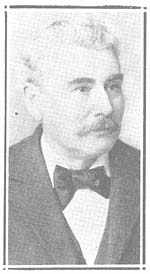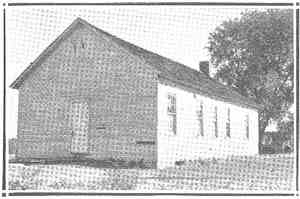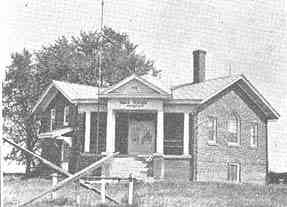|
MACON
county pioneers recognized the importance of
having schools. Many of them had come from
educational environments, others had not, but
all of them wanted advantages for their
children. There was then no public school
system, in Illinois and they were not going to
wait until one was perfected.
AS a result there have been schools in the
county ever since its beginning, in fact, before
the county was laid out. Naturally, the
first ones where crude and poor, but so was
everything else at the time. Buildings
were made of longs. Furniture was cut from
the timber. Seats were slabs supported by
sticks. Desks were puncheon shelves,
fastened on wooden pins driven into the walls.
Sections of logs at the sides of the building
were cut out to make windows, and the holes
covered with greased paper.
Some of the earliest teachers were as poor in
proportion as their surroundings. A
teacher had to be picked up anywhere he could be
found, and often he knew little more than the
pupils. One did not have to know much.
The instructor of that day did not worry about a
teacher's certificate. Yet there were some
good teachers, too.1
Most of the early teachers were men. It
required brawn as well as brain then, and
handling a school was considered to hard for a
woman.
After 1872, when the law was amended to
require teachers to pass an examination, the
standard of the teaching profession was raised.
The earliest schools were all of the
subscription type. A subscription paper
was passed, and patrons subscribed what they
could give to the support of a school.
When enough money was in sight, a teacher was
employed. Patrons were expected to
subscribe according to the number of children
they had in school, though that wasn't always
possible.
FIRST SCHOOLS
Records available today on the early schools
of the county did not agree as tot he date of
erection of the first school building.
Lewis B. Ward, one of the pioneers, said
that eh first school building was erected in
1825 on the old Widick place, later known
as the P. M. Wikoff land, three and
one-half miles southwest of Decatur and that the
first teacher was named Taylor, generally
called "Frozen" Taylor. The land
was first known as the Lewis B. Ward land, and
the school was called the Ward school.
According to old residents this was the school
afterwards known as the Cross Roads school, so
it has had continuous existence since 1825.
The first building was abandoned in 1845.
Since then the school has had four different
buildings.
The second school building in Macon county,
according to Lewis B. Ward, was built in
1828 on land southwest of Decatur owned later by
W. C. Smith. In this building
Abraham Lincoln attended "spellings" and
other gatherings. A man named Nelson,
called "A Little Yankee," taught there.
Other records say that the first house
erected for school purposes was put up in 1826
on Stevens creek, in the neighborhood of the
Stevens settlement.
In Blue Mound township, according to report,
there was a school as early as 1828, with Daniel
McCall as teacher.
In the year 1829 or 1830 a school was erected
in Harristown township on James Miller's
land.
Friends Creek township had a school as early
as 1835 and 1836, the first building for the
purpose being erected in 1838.
In Mt. Zion township a schoolhouse was
erected about 1840 about three-quarters of a
mile west of the present village of Mt. Zion.
Long Creek township had a school building as
early as 1834, located in Section 16.
Daniel Stickel was the first teacher.
What was know as the Orthodox school house
was built in Whitmore township in 1841 by free
contributions of such materials as the settlers
could provide. This building was designed
for common school, singing school, spelling
school, debating societies, lecture room,
political meetings, and other public uses.
It was constructed entirely of oak. It
occupied the site of what became the Union
cemetery.
Oakley township had a school as early as
1830, with Alexander Patton as the first
teacher.
Mt. Gilead was one of the earliest of the
country schools. At first its area covered
about all of what is now South Wheatland
township. This school is now known as Elm
Grove, and the present building is a short
distance north of the site of the first school
house.
One of the well known early schools was the
Bagdad school. The building was erected
for both church and school purposes. It
was on a lot donated by Samuel Cox, and
stood on the present site of the Sharon
Methodist church. Previous to the erection
of this building church services had been held
in the homes of Glenn Church, John
Gulick and others. After this building
was outgrown, separate buildings were erected.
The church remained on the same site, but the
school was located at a different point, a mile
east and south and it became known as a
Sunnyside school.
Another early school was the Bull Point
school north of Decatur on the Bloomington road,
in Hickory Point township. It was erected
on land belonging to William F. Montgomery.
County school commissioner was the title
given to the director of schools in the county
in the beginning. In 1865 the title was
changed to county superintendent of schools.
So far as records show, James Johnson was
the first school commissioner of Macon county,
serving from 1832 to 1834. After him came
the following:
SUPERINTENDENTS
|
1834-1835 - James
Bradshaw |
1860-1864 - C. C.
Burroughs |
|
1835-1838 - Charles
Emerson |
1864-1869 - Edwin
Parks |
|
1838-1840 - H. M.
Gorin |
1869-1873 - O. F.
McKim |
|
1840-1847 - P. D.
Williams |
1873-1877 - S. P.
Nickey |
|
1847-1860 - W. S.
Crissey |
|
JOHN TRAINER
By this time schools had made great advance
in Illinois and were on higher levels, but the
year 1877 saw the beginning of the regime of a
county superintendent, who not only put Macon
county "on the map," so far as rural school work
was concerned, but who started a system that was
adopted by the state of Illinois and many other
states as well.
The man who made Macon county famous in
school circles was John Trainer, who
served as the county superintendent from 1877 -
1885.
He is called the father of the system of
grading in country schools, the course of study
and the standardizing of rural schools. He
is credited with having done more for the rural
schools than any other educator in Illinois.

JOHN TRAINER
"Trainer's Manual and Guide" developed into a
booklet known as the "Macon County Guide" and
was used as a basis for manuals printed by other
county superintendents, and finally grew into a
state course of study for country schools.
It has been adopted by a number of states.
Trainer published various books and helps.
One of his books was "How to Study United States
History." Mr. Trainer had marked
ability as a teacher and was a man who inspired
pupils, as well as teachers and parents.

OLD FORSYTH SCHOOL BUILDING
Since Mr. Trainer the position of
county superintendent of schools has been filed
by the following:
1886 - 90 - Thomas
L. Evans
1890 - 94 - John N. Donahey
1894 -1902 - John G. Keller
1902 - 06 - A. A. Jones
1906 - 10 - Leona F. Bowman
1910 - 18 - Mary Moore Eyman.
1918 88- 22 - Everett L.
Dicket
1922 to date - Cora B. Ryman. |
In 1877 the plan to hold annual teacher's
institutes was inaugurated. Before that,
such institutes had been held occasionally.
What is believed to be the oldest rural
school building now standing in the country is
the old building at Forsyth now used as a
machine shop. It was erected in 1864 and
was used as a school until 1927 when the present
day building was constructed.
One of the best of the modern day rural
school buildings is the Brick school west of
Warrensburg. There are many other splendid
structures, with modern equipment.
Today Macon county has 5,000 pupils in the
rural schools, according to the 1929 report of
the county superintendent. Two hundred and
sixteen teachers direct them. There are
129 schools with one teacher, and five with two.
This does not include Brush college district, in
a class by itself with two buildings having nine
rooms and nine teachers.

A MODERN DAY RURAL SCHOOL
(The Brick School)
As the old log school houses gave way years
ago to improved type of buildings, so have the
old ways of teaching given way to up to date
methods of instruction and supervision.
Macon county can be proud of the high standard
reached by its rural schools.
--------------------
1
One story, told by the late E. O. Smith, as to
the qualifications of early school teachers says
that one day neighbors were discussing the
attainments of a certain young woman who had
just completed a term as teacher. One old
man admitted that the teacher was well educated,
but said that "she did not know everything, for
every time she talked about a "cheer' she called
it a 'chair'.
<PREVIOUS> <NEXT>
<CLICK HERE TO RETURN TO TABLE OF CONTENTS>
|